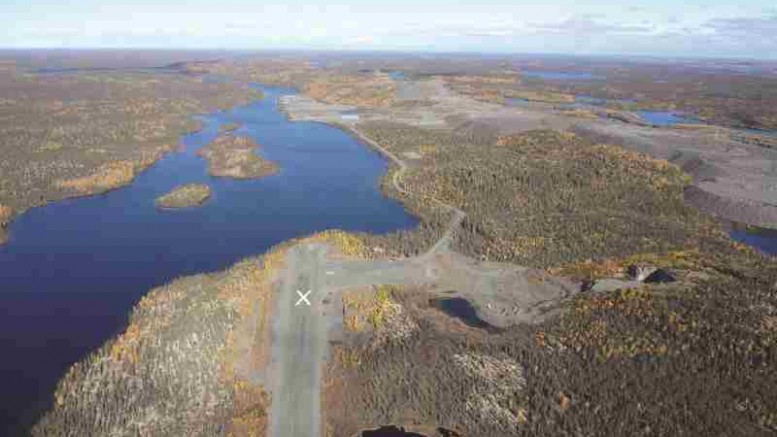Gold finds in the Far North don’t begin and end with the Yukon.
While the territory has hogged much of the exploration headlines over the last few years, Nighthawk Gold (NHK-V) is reminding investors that the territory to the east still has a golden lustre all its own.
After consolidating 900 sq. km of land at the Indin Lake gold camp, Nighthawk holds over 90% of an Archean greenstone belt located 220 km north of Yellowknife in the Northwest Territories.
The permits cover an area within the north-trending West Bay-Indin Lake fault corridor, which has yielded over 13 million oz. gold and offers similarities — in terms of structure and rock age — with the famed Abitibi and Red Lake Archean belts to the south.
And while its an enviable problem to have, controlling such a large area makes it hard to decide where to put exploration capital.
Fortunately, Nighthawk has the past as its guide.
The project’s epicentre holds the historic Colomac gold mine, which stopped producing when Peggy Witte’s Royal Oak Mines went bankrupt in 1997. Somewhat ironically, the rough shape Royal Oak left the land in is what opened the door to Nighthawk a dozen years later.
With environmental safeguards not being up to snuff in the 1990s, Royal Oak simply walked away from an environmental mess once the company became insolvent. And that meant the government in Yellowknife was left with an expensive cleanup on its hands.
Nighthawk, which was then Merc International Minerals, had strategically staked and acquired most of the prospective ground around the old mine site, reasoning that once the cleanup was done, Colomac itself would become available.
This came sooner than anticipated, and with the government short on funds, it reached out to the most likely source.
“We surrounded them,” David Wiley, Nighthawks chief executive explains of the government’s willingness to deal exclusively with Nighthawk. “When they were nearly done they looked up and thought, ‘holy cow,’ we were all around them . . . so they called us.”
The two parties agreed that Nighthawk would post a $5-million bond to cover the remaining reclamation costs — expenses that Wiley believes could turn out to be less than $5 million, in which case Nighthawk would be reimbursed for the difference — in exchange for Nighthawk being granted the permits for the property.
The deal ensured the mess was cleaned up, and Nighthawk acquired a past producer, with significant upside potential, without having to go through an auction process. One miner’s mess had become another explorer’s opportunity.
So what did Nighthawk get for its $5-million bond?
Colomac contains five known gold deposits, all of which are open in all directions. Only the Colomac dyke deposit was mined. The deposit went to the mill intermittently between 1990 and 1997 and turned out 527,908 oz. gold, with an average head grade of 1.66 grams per tonne.
Mining occurred in three shallow open pits developed on a steeply dipping, quartz-feldspar porphyry intrusion known as the Colomac dyke.
Historical mining has just scratched the surface of the dyke’s 7-km mineralized strike length — and Wiley and Nighthawk’s chief geologist Michael Byron unfurl a 3-metre-long cross-section of drill results from the zone that clarifies how much strike they are dealing with.
Some of the highlights from its winter drilling program across the stretch include 128 metres grading 1.36 grams gold, 56 metres grading 1.67 grams gold and 2 metres grading 31.2 grams gold.
So far the company has drilled 8,500 metres of its 11,000-metre drill program. Roughly 3,700 metres have been assayed and reported on, and Wiley says he expects results from the entire program by this October.
The assays, combined with historic core left at the site that is being logged and re-sampled, will likely contribute to a bulked-up resource estimate that will consider a greater breadth of mineralization than what was historically outlined.
Byron explains that, given such a long band of mineralized strike, the plan has been to focus on areas within the Colomac dyke that have already yielded strong results, and drill those areas out further to see if it can widen the relatively narrow band of mineralization.
“If we can extend along strike, it’s cheaper than drilling at depth,” Byron says, although he points out that historic deep holes extending to depths of 700 and 1,000 metres bottomed out in mineralization, with grades similar to those found in the mined open pit.
Nighthawk has so far outlined inferred resources of 42.7 million tonnes, with an average grade of 1.05 grams gold for 1.45 million oz. gold.
The Colomac dyke accounts for the lion’s share of ounces, and the North, Central and South section of the dyke contribute 1.3 million oz. to the resource.
The remaining ounces come from the Goldcrest dyke and the Grizzly Bear deposit, which are both parallel and west of the Colomac dyke, and Zones 24 and 27, which are located east of the northern part of Colomac.
Exploring in the wilds of the Far North means that good aboriginal relations are a major part of any future success. Wiley is attuned to this, and says relations with the local Tlicho people are on solid footing.
The community and the company lobbied for the government to build an ice road — which Wiley says shows the community’s economic savvy and its eagerness for more development in the region.
On the capital front Nighthawk is well positioned to drive the project forward: It has $9 million left in the bank from a $12-million equity financing done in March.


Be the first to comment on "Nighthawk to soar on NWT gold"